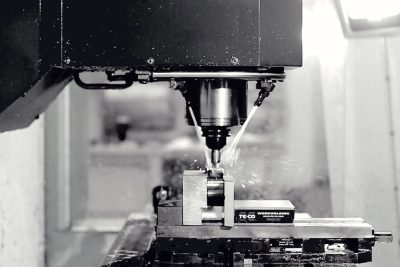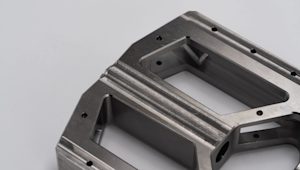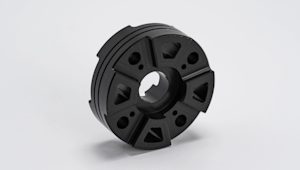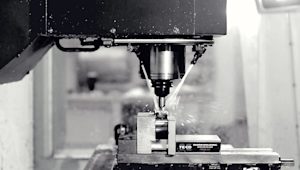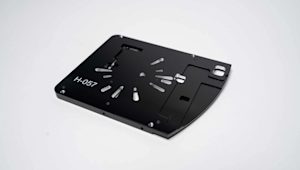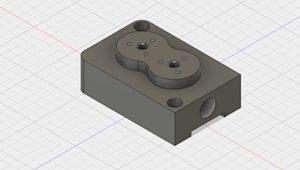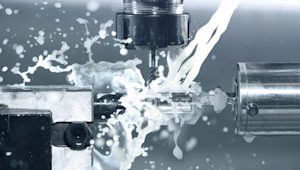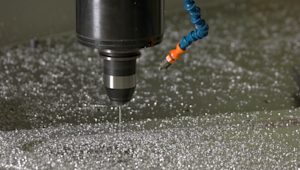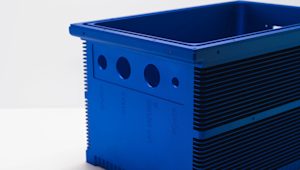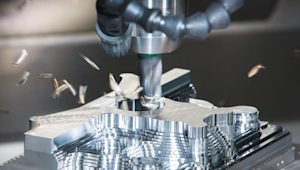CNC milling is a machining process that combines computer numerical control machining systems and a multi-point cutting tool or milling cutter. As one type of CNC machining, it involves mounting the workpiece on a machine bed and cutting materials from a solid block to produce products made of glass, metal, plastic, wood and more specialized materials.
This guide shows how CNC milling machines work, explores the different types of CNC milling machines and provides design advice for getting the most out of CNC manufacturing.
Did you know we offer local sourcing for CNC machining?
How do CNC milling machines work?
To break it down in the simplest way possible, CNC milling involves a four-step process:
Step 1: Create a CAD model
Machinists use a design program such as Autodesk Fusion 360 to create a CAD model of a specific component.
Step 2: Convert CAD model for CNC machine
Next, import the CAD model into the CAM computer-aided manufacturing system. Done right, you’ll end up with a series of digital instructions that tell the CNC machine what to do—otherwise known as G-code. G-code commands let machines identify where to move and how fast to do it to make a specific component.
Step 3: Set-up up the CNC milling machine
Attach the workpiece or block of material on the machine bed—and make sure it's properly aligned through metrology tools or touch probes. Install the machine spindle and do all steps required for setting up the milling machine.
Step 4: Begin the milling process
Load the program to start the CNC milling process. The specialized cutting tools rotate at high speed or a fixed revolution per minute to subtract material from the workpiece—until it accurately replicates the desired component.
What’s the difference between CNC milling and CNC turning?
While CNC milling and CNC turning rely on CNC systems, there are key differences between the two machining processes.
CNC turning is done to build a conical or cylindrical surface. The turning process requires a lathe—a machine tool that can rotate a workpiece around an axis of rotation— to perform various operations like cutting, drilling, turning and threading. It also uses an SPTT or a single-point turning tool that’s in direct contact with the workpiece throughout the operation.
CNC milling is used to generate a flat surface using a milling machine. It requires a multi-point cutting tool or a milling-cutter. Unlike turning, the milling process relies on intermittent cutting and multiple machine steps.

What are 3-, 4- and 5-axis milling machines?
Let’s take a look a the various types of milling machines:
3-axis milling machines let the cutting tool move and subtract parts through the X, Y and Z axes. This type of machining method is the most popular because of its low start-up costs. It’s also used to manufacture simple parts with an uncomplicated geometry.
A 4-axis milling machine has all the capabilities of a 3-axis milling machine—plus an additional axis. In addition, it allows for the rotation of the workpiece for cutting around the A-axis. This is particularly useful when parts need to be cut around a cylinder or the side of a piece.

The 5-axis milling machine allows for movement along the three linear axes, the rotation of the machine head and the tool head—which make up five axes combined. As a result, it can generate products with complex geometries such as aerospace products, titanium pieces, medical products and gas machine parts. Because it is capable of multidimensional rotation, it eliminates the necessity of multiple setups and allows for single-step machining which is faster and more productive.

What kinds of parts can you make with CNC milling machines?
CNC milling machines let operators create complex designs with very tight tolerances. As a result, it is one of the most accurate manufacturing techniques to date.
Here’s a look at the products you can create:
-
Aerospace components such as landing gear components, fuselage structures
-
Components for the automotive industry such as control panels, axles, car molds
-
Consumer electronics components such as enclosures
-
Medical components such as surgical instruments, orthotics
-
Oil and gas machine parts such as valves, rods, pins
-
Prototyping and modeling
-
Sculptures
-
Furniture
-
Woodworking
CNC milling machines can cut a large variety of materials such as aluminum, bronze, copper, ceramics, plywood, various types of steel, stone, wood, zinc, and other engineering materials. This makes it ideal for creating prototypes for product development. You can also make accurate and quick adjustments until you’re satisfied with the end product.

While CNC milling machines are flexible, there are limitations in terms of the axis movement, prototype size, and drill bit size. Most machines have shape and size limitations. Large CNC machines can create prototypes up to 105 feet x 21 feet.
Meanwhile, the smallest machines are limited to movement of up to 9 inches along the x-axis, 5.125 inches along the y-axis, and 6.5 inches along the z-axis. Due to shape limitations, some machines may have issues drilling square-edged holes in the material.
How do you design parts for CNC milling?
There are many design factors to consider when creating parts for CNC milling. In general, some of the significant recommendations from our in-house team of mechanical engineers include the following:
-
Minimize set-ups: Try to minimize the number of setups required for creating a part, so the milling process becomes faster and more efficient.
-
Consider the internal corner radii: Internal corner radii must be added to the parts. It should at least be 1/4 the depth of the cut and preferably around 1/2 the depth of cut (or as large the design allows) for cost savings. Whenever possible, minimize the depth of pockets and drill holes instead of milling shapes.
-
Avoid thin walls and thin sections of a part: During the milling process, machining forces are capable of deflecting and warping a part even with soft metals. If a section of a part doesn't need to be thin, don't make it thin. Done right, you’ll be able to speed up production, reduce cost, and improve the surface finish of the workpiece
-
Consider part size: For smaller features, you’ll need smaller and more fragile tools. Small tools are harder to work with and run slower which increases costs. If a feature doesn't need to be small for the part to work, make it bigger.
-
Standardize everything: Use standard thread sizes, standard corner radii, standard materials, and standard tolerances to save money and ensure parts arrive on time, regardless of who is making them.
Which tool or design works best for which material?
Materials for machining fall into three major groups: plastics, soft metals, and hard metals.
Soft metals and certain hard metals have the tightest possible tolerances, which makes them relatively easy to work with. Once a material leaves the sweet spot for hardness and turns "too hard" or "too soft," it reacts unexpectedly to some manufacturing processes and the accuracy when cutting it is significantly reduced.
As a result, some materials are more often used and considered the industry standard compared to others. For instance, aluminum 6061-T6 or various types of mild steel are popular among machinists because they are easy to work with and possess great properties.
Are there software tricks that engineers should know to design for manufacturability?
CAD software is designed to craft simple-to-use tools which align well with the simple-to-manufacture parts.
For example, the tool "Hole Wizard'' can quickly generate standard-sized holes on a part which makes the process convenient for both designers and manufacturers. In addition, it's also easier to use the basic “Extrude” or “Revolve” tools than more complicated tools like “Lofts” or “Sweeps.”
Generally, it’s simpler to mass produce and manufacture a part made with simple tools than one with complex surfaces. If your part doesn't require a complex feature, avoid integrating it into your design. This will help you save money and minimize quality issues related to your design in the long run.
How do you get the most out of CNC milling with Protolabs Network?
There are many many ways to reduce costs and accelerate lead times for CNC milling. In general, much of what you can do boils down to designing ”Simple” and/or “Standard” parts. If you can design parts with simple features that can be built with standard-sized tooling, they’ll come out successfully more often than not.
Complexity is fine when it's necessary, but it also leads to increased lead time and cost. A simple part with relatively tight tolerances or one complex feature may not be too difficult when made of aluminum. However, when made of plastic, mass production may seem nearly impossible.
To sum it up, anything that can be simple and standard in your design should be. Adding complex features or opting for a specialized material may be necessary depending on your current product development stage, but these will definitely make milling more intensive.
Protolabs Network's CNC milling services comprise a global network of 3-axis, 3+2-axis and full 5-axis milling centers that can manufacture highly accurate and quality parts. Start producing parts now with a free, instant quote.
Frequently asked questions
What materials does CNC milling use?
Materials for CNC milling generally fall into three major categories: plastics, soft metals, and hard metals. Examples include aluminum, bronze, copper, ceramics, plywood, steel, stone, wood and zinc among others. Materials considered to be easy to work with and equipped with great properties are more often used compared to other viable materials.
What are the ideal applications for aluminum?
Aluminum is an ideal material for CNC milling because it chips easily and is corrosion-resistant. Ideal applications include aircraft fittings, architectural materials, medical components, gears and shafts among others.
What are the best alternatives for aluminum?
Steel and stainless steel are popular alternatives to aluminum for CNC machining. Because of their strength and temperature resistance, they are relatively easy to work with.
Is CNC machining the same as milling?
CNC milling is one type of CNC (computer numerical control) machining system. It involves mounting the workpiece on a machine bed and utilizing these systems to produce CNC machining parts with greater accuracy and precision.
Is CNC milling expensive?
There are ways you can reduce the cost of CNC milling. If you design simple parts and utilize standard-sized tooling, you can increase the chances of successfully producing a component with minimal costs. Other CNC machining design tips include adding internal corner radii to the parts, avoiding thin walls and sections of a part and opting for bigger features instead of smaller ones.
What are common uses for CNC milling?
CNC milling is one of the most accurate manufacturing techniques which makes it ideal to create complex designs. It can be used to create products such as aerospace components, furniture, medical components, prototypes, titanium pieces, and woodworking.
What are some common mills used in manufacturing?
The most common mills used in manufacturing are CNC lasers, CNC lathes, CNC mills, CNC plasma cutters, and CNC routers. The CNC machine of your choice will depend on your preferred process and the type of product you want to build.
What is a CNC milling machine?
A CNC milling machine is a combination of computer numerical control machining systems and a milling cutter. The milling cutter can cut parts from the workpiece with precision and accuracy to create the final product.
What is a CNC milling machine used for?
CNC milling is used to manufacture products made of glass, metal, plastic, wood and custom-designed components. Machinists can produce prototypes and products for industries such as aerospace, automotive, hardware startups, manufacturing, medical devices, robotics and more.






